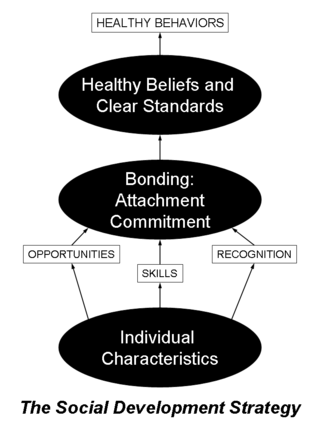Peer pressure is a direct or indirect influence on peers, i.e., members of social groups with similar interests, experiences, or social statuses. Members of a peer group are more likely to influence a person's beliefs, values, religion and behavior. A group or individual may be encouraged and want to follow their peers by changing their attitudes, values or behaviors to conform to those of the influencing group or individual. For the individual affected by peer pressure, this can have both a positive or negative effect on them.

Juvenile delinquency, also known as juvenile offending, is the act of participating in unlawful behavior as a minor or individual younger than the statutory age of majority. These acts would otherwise be considered crimes if the individuals committing them were older. The term delinquent usually refers to juvenile delinquency, and is also generalised to refer to a young person who behaves an unacceptable way.
School violence includes violence between school students as well as attacks by students on school staff and attacks by school staff on students. It encompasses physical violence, including student-on-student fighting, corporal punishment; psychological violence such as verbal abuse, and sexual violence, including rape and sexual harassment. It includes many forms of bullying and carrying weapons to school. The one or more perpetrators typically have more physical, social, and/or psychological power than the victim. It is a widely accepted serious societal problem in recent decades in many countries, especially where weapons such as guns or knives are involved.

Positive youth development (PYD) programs are designed to optimize youth developmental progress. This is sought through a positivistic approach that emphasizes the inherent potential, strengths, and capabilities youth hold. PYD differs from other approaches within youth development work in that it rejects an emphasis on trying to correct what is considered wrong with children's behavior or development, renouncing a problem-oriented lens. Instead, it seeks to cultivate various personal assets and external contexts known to be important to human development.
Oppositional defiant disorder (ODD) is listed in the DSM-5 under Disruptive, impulse-control, and conduct disorders and defined as "a pattern of angry/irritable mood, argumentative/defiant behavior, or vindictiveness". This behavior is usually targeted toward peers, parents, teachers, and other authority figures, including law enforcement officials. Unlike conduct disorder (CD), those with ODD do not generally show patterns of aggression towards random people, violence against animals, destruction of property, theft, or deceit. One-half of children with ODD also fulfill the diagnostic criteria for ADHD.
Youth mentoring is the process of matching mentors with young people who need or want a caring, responsible adult in their lives. Adult mentors are usually unrelated to the child or teen and work as volunteers through a community-, school-, or church-based social service program. The goal of youth mentoring programs is to improve the well-being of the child by providing a role model that can support the child academically, socially and/or personally. This goal can be accomplished through school work, communication, and/or activities. Goals and settings within a mentoring program vary by country because of cultural values.
Psychological resilience is the ability to cope mentally and emotionally with a crisis, or to return to pre-crisis status quickly.
Emotional and behavioral disorders refer to a disability classification used in educational settings that allows educational institutions to provide special education and related services to students who have displayed poor social and/or academic progress.
Childhood trauma is often described as serious adverse childhood experiences (ACEs). Children may go through a range of experiences that classify as psychological trauma; these might include neglect, abandonment, sexual abuse, emotional abuse, and physical abuse, witnessing abuse of a sibling or parent, or having a mentally ill parent. These events have profound psychological, physiological, and sociological impacts and can have negative, lasting effects on health and well-being such as unsocial behaviors, attention deficit hyperactivity disorder (ADHD), and sleep disturbances. Similarly, children whose mothers have experienced traumatic or stressful events during pregnancy have an increased risk of mental health disorders and other neurodevelopmental disorders.

A residential treatment center (RTC), sometimes called a rehab, is a live-in health care facility providing therapy for substance use disorders, mental illness, or other behavioral problems. Residential treatment may be considered the "last-ditch" approach to treating abnormal psychology or psychopathology.
After-school activities, also known as after-school programs or after-school care, started in the early 1900s mainly just as supervision of students after the final school bell. Today, after-school programs do much more. There is a focus on helping students with school work but can be beneficial to students in other ways. An after-school program, today, will not limit its focus on academics but with a holistic sense of helping the student population. An after-school activity is any organized program that youth or adult learner voluntary can participate in outside of the traditional school day. Some programs are run by a primary or secondary school, while others are run by externally funded non-profit or commercial organizations. After-school youth programs can occur inside a school building or elsewhere in the community, for instance at a community center, church, library, or park. After-school activities are a cornerstone of concerted cultivation, which is a style of parenting that emphasizes children gaining leadership experience and social skills through participating in organized activities. Such children are believed by proponents to be more successful in later life, while others consider too many activities to indicate overparenting. While some research has shown that structured after-school programs can lead to better test scores, improved homework completion, and higher grades, further research has questioned the effectiveness of after-school programs at improving youth outcomes such as externalizing behavior and school attendance. Additionally, certain activities or programs have made strides in closing the achievement gap, or the gap in academic performance between white students and students of color as measured by standardized tests. Though the existence of after-school activities is relatively universal, different countries implement after-school activities differently, causing after-school activities to vary on a global scale.

Substance abuse prevention, also known as drug abuse prevention, is a process that attempts to prevent the onset of substance use or limit the development of problems associated with using psychoactive substances. Prevention efforts may focus on the individual or their surroundings. A concept that is known as "environmental prevention" focuses on changing community conditions or policies so that the availability of substances is reduced as well as the demand. Individual Substance Abuse Prevention, also known as drug abuse prevention involves numerous different sessions depending on the individual to help cease or reduce the use of substances. The time period to help a specific individual can vary based upon many aspects of an individual. The type of Prevention efforts should be based upon the individual's necessities which can also vary. Substance use prevention efforts typically focus on minors and young adults – especially between 12–35 years of age. Substances typically targeted by preventive efforts include alcohol, tobacco, marijuana, inhalants, coke, methamphetamine, steroids, club drugs, and opioids. Community advocacy against substance use is imperative due to the significant increase in opioid overdoses in the United States alone. It has been estimated that about one hundred and thirty individuals continue to lose their lives daily due to opioid overdoses alone.
Youth suicide is when a young person, generally categorized as someone below the legal age of majority, deliberately ends their own life. Rates of youth suicide and attempted youth suicide in Western societies and other countries are high. Youth suicide attempts are more common among girls, but adolescent males are the ones who usually carry out suicide. Suicide rates in youths have nearly tripled between the 1960s and 1980s. For example, in Australia suicide is second only to motor vehicle accidents as its leading cause of death for people aged 15 to 25.

Communities That Care (CTC) is a program of the Center for Substance Abuse Prevention (CSAP) in the office of the United States Government's Substance Abuse and Mental Health Services Administration (SAMHSA). CTC is a coalition-based prevention operating system that uses a public health approach to prevent youth problem behaviors such as violence, delinquency, school drop out and substance abuse. Using strategic consultation, training, and research-based tools, CTC is designed to help community stakeholders and decision makers understand and apply information about risk and protective factors, and programs that are proven to make a difference in promoting healthy youth development, in order to most effectively address the specific issues facing their community's youth.
Bullying is abusive social interaction between peers and can include aggression, harassment, and violence. Bullying is typically repetitive and enacted by those who are in a position of power over the victim. A growing body of research illustrates a significant relationship between bullying and emotional intelligence.
School-based family counseling (SBFC) is an integrated approach to mental health intervention that focuses on both school and family in order to help children overcome personal problems and succeed at school. SBFC is practiced by a wide variety of mental health professionals, including: psychologists, social workers, school counselors, psychiatrists, and marriage and family therapists, as well as special education teachers. What they all share in common is the belief that children who are struggling in school can be best helped by interventions that link family and school. SBFC is typically practiced at the school site, but may be based in a community mental health agency that works in close collaboration with schools.
School climate refers to the quality and character of school life. It has been described as "the heart and soul of the school ... that essence of a school that leads a child, a teacher, and an administrator to love the school and to look forward to being there each school day." A positive school climate helps people feel socially, emotionally and physically safe in schools. It includes students', parents' and school personnel's norms, beliefs, relationships, teaching and learning practices, as well as organizational and structural features of the school. According to the National School Climate Council, a sustainable, positive school climate promotes students' academic and social emotional development.
Adverse childhood experiences (ACEs) include childhood emotional, physical, or sexual abuse and household dysfunction during childhood. The categories are verbal abuse, physical abuse, contact sexual abuse, a battered mother, household substance abuse, household mental illness, incarcerated household members, and parental separation or divorce. The experiences chosen were based upon prior research that has shown to them to have significant negative health or social implications, and for which substantial efforts are being made in the public and private sector to reduce their frequency of occurrence. Scientific evidence is mounting that such adverse childhood experiences (ACEs) have a profound long-term effect on health. Research shows that exposure to abuse and to serious forms of family dysfunction in the childhood family environment are likely to activate the stress response, thus potentially disrupting the developing nervous, immune, and metabolic systems of children. ACEs are associated with lifelong physical and mental health problems that emerge in adolescence and persist into adulthood, including cardiovascular disease, chronic obstructive pulmonary disease, autoimmune diseases, substance abuse, and depression.
Education in emergencies and conflict areas is the process of teaching and promoting quality education for children, youth, and adults in crisis-affected areas. Such emergency settings include: conflicts, pandemics and disasters caused by natural hazards. Strengthened education systems protects children and youth from attack, abuse, and exploitation, supports peace-building, and provides physical and psychological safety to children. In times of crisis, education helps build resilience and social cohesion across communities, and is fundamental to sustained recovery.
Community crime prevention relates to interventions designed to bring reform to the social conditions that influence, and encourage, offending in residential communities. Community crime prevention has a focus on both the social and local institutions found within communities which can influence crime rates, specifically juvenile delinquency.




